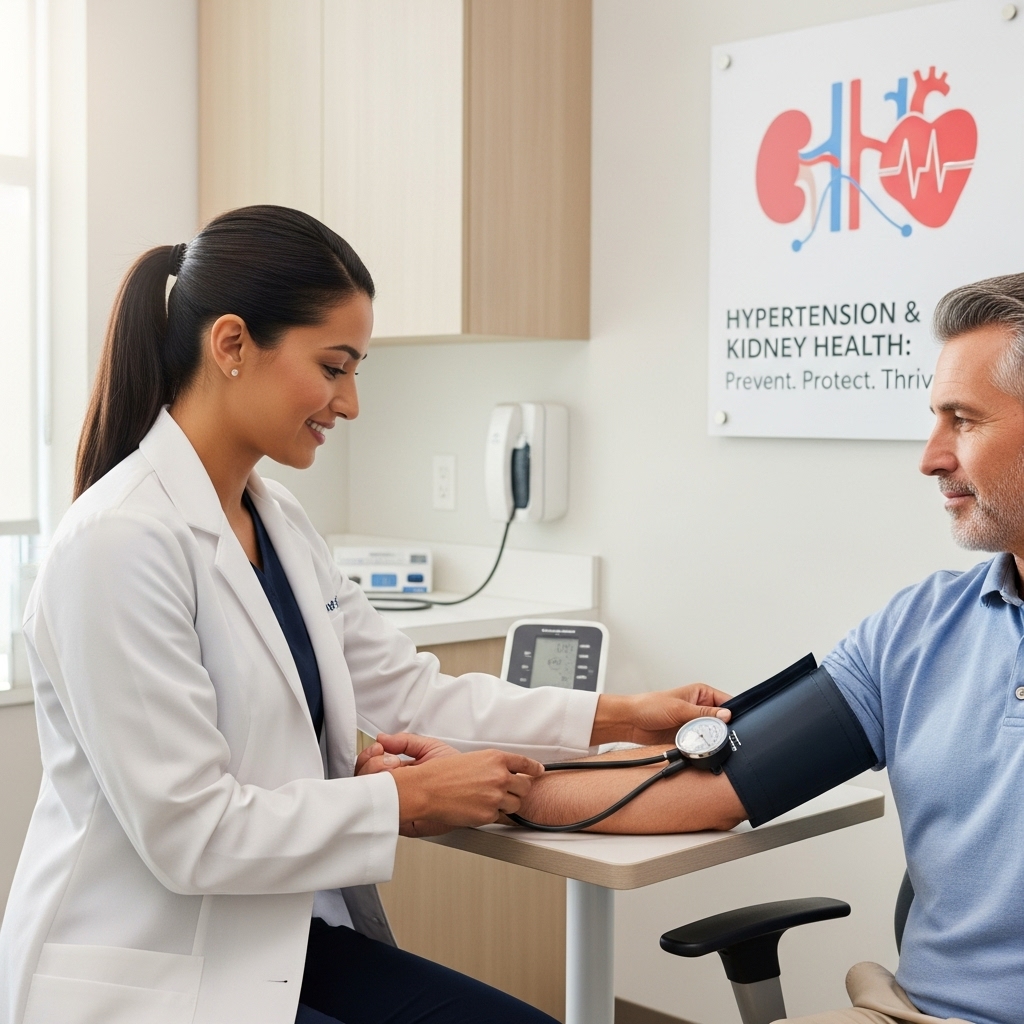High blood pressure, or hypertension, is a common condition that can have serious health consequences, particularly for your kidneys. Understanding the relationship between blood pressure and kidney health is crucial in managing and potentially slowing the progression of chronic kidney disease (CKD). In this article, we’ll explore how you can effectively monitor and control your blood pressure to protect your kidney function.
Your kidneys are vital organs responsible for filtering waste and excess fluids from your blood. High blood pressure can damage the blood vessels in your kidneys, reducing their ability to function properly. Over time, this damage can lead to kidney disease, which can further exacerbate hypertension, creating a dangerous cycle.
How Hypertension Affects the Kidneys
Hypertension puts added strain on the delicate blood vessels in your kidneys. When these vessels are damaged, they can’t effectively filter blood, leading to a buildup of waste products and fluids. This can cause further increases in blood pressure and more damage to the kidneys, potentially resulting in kidney failure.
Recognizing Kidney Disease Symptoms
Kidney disease often progresses silently, with symptoms not appearing until significant damage has occurred. However, early signs to watch for include:
- Fatigue and weakness
- Trouble concentrating
- Swelling in your feet and ankles
- Frequent urination, especially at night
- Muscle cramps
- Dry and itchy skin
If you notice any of these symptoms, consult your healthcare provider for a thorough evaluation.
Learn more about managing blood pressure to protect your kidneys.
Home Blood Pressure Monitoring for CKD

Monitoring your blood pressure at home can be a powerful tool in managing CKD. Regular measurements help you understand your blood pressure patterns and alert you to any concerning changes. Here’s how to get started:
Choosing the Right Monitor
Select a reliable home blood pressure monitor that fits your needs. Look for one that’s easy to use, with a clear display and memory storage to track your readings over time. Automatic, cuff-style monitors are often the most user-friendly and accurate.
How to Take Accurate Readings
- Prepare yourself: Avoid caffeine, exercise, and smoking for at least 30 minutes before measuring your blood pressure. Sit quietly for five minutes before beginning.
- Position yourself correctly: Sit with your back straight, feet flat on the floor, and arm supported at heart level.
- Follow instructions: Use the cuff on your bare arm, following the manufacturer’s instructions. Take multiple readings and average them for accuracy.
Best Blood Pressure Medications for CKD
Managing blood pressure in CKD often involves medication. Your healthcare provider will tailor your treatment plan based on your individual needs. Common blood pressure medications for CKD include:
ACE Inhibitors and ARBs
These medications help relax blood vessels, lowering blood pressure and reducing kidney damage. They are often the first choice for managing hypertension in CKD patients.
Diuretics
Diuretics, or “water pills,” help your kidneys remove excess sodium and water from your body, reducing blood pressure. They are often used in combination with other blood pressure medications.
Calcium Channel Blockers
These medications relax the muscles of your blood vessels, helping to lower blood pressure. They can be effective for CKD patients who cannot tolerate ACE inhibitors or ARBs.
Lifestyle Changes to Protect Your Kidneys

by Robina Weermeijer (https://unsplash.com/@averey)
In addition to medication, lifestyle changes can play a significant role in managing blood pressure and protecting your kidneys. Consider the following strategies:
Reduce Salt Intake
Excess salt can raise blood pressure and further damage your kidneys. Aim to consume less than 2,300 milligrams of sodium per day, or less if recommended by your healthcare provider. Read food labels carefully and limit processed foods, which are often high in sodium.
Maintain a Healthy Weight
Carrying excess weight can increase your risk of hypertension and kidney disease. Focus on a balanced diet rich in fruits, vegetables, whole grains, and lean proteins. Regular physical activity can also help you achieve and maintain a healthy weight.
Stay Active
Aim for at least 150 minutes of moderate-intensity exercise each week, such as brisk walking, swimming, or cycling. Regular physical activity can help lower blood pressure and improve overall kidney health.
Limit Alcohol and Avoid Tobacco
Excessive alcohol consumption can raise blood pressure and damage your kidneys. Limit your intake to no more than one drink per day for women and two drinks per day for men. Avoid tobacco products, as smoking can worsen kidney damage and hypertension.
The Role of Regular Check-Ups and Monitoring
Regular check-ups with your healthcare provider are essential in managing CKD and hypertension. These appointments provide an opportunity to monitor your kidney function, blood pressure, and overall health. Your provider can adjust your treatment plan as needed and offer guidance on lifestyle changes.
Blood Pressure Goals for CKD Patients
For most CKD patients, the target blood pressure is below 130/80 mm Hg. However, your specific goal may vary based on your overall health and risk factors. Work with your healthcare provider to determine the best target for you.
Discover more about the relationship between high blood pressure and kidney disease.
Conclusion
Managing your blood pressure is a crucial step in protecting your kidneys and slowing the progression of CKD. By understanding the connection between hypertension and kidney damage, monitoring your blood pressure at home, taking the appropriate medications, and making lifestyle changes, you can take control of your health. Regular check-ups and open communication with your healthcare provider will further support your efforts in maintaining optimal kidney function and overall well-being.

